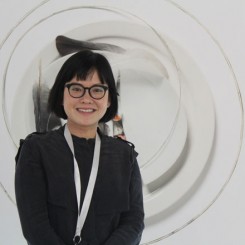Singaporean native and Sotheby’s graduate Audrey Yeo is a founding partner of Galerie 8, formerly in Hackney, London. She is working now on moving the gallery back to Singapore, newly incarnated as Yeo Workshop. The gallery is focused on emerging artists, and as Yeo detects a tendency amongst both galleries and collectors alike to be nationalistic in their selections, on impressive work rather than the origin of the artist.
Iona Whittaker: The first question is about your move to London and starting the gallery — what’s your story?
Audrey Yeo: Well, that’s a long story. I moved to London a couple of years ago; I did my Masters at Sotheby’s Institute, and have since been the Director of Galerie 8. And then this (Yeo Workshop) is a re-branding as the gallery moves back to Singapore. I think that there’s a lot of potential, and it’s also something personal for me. What I’m interested in is personal histories — I mean, someone came into the booth today and said “I only collect South-East Asian,” and I said “You and the rest of the world are very nationalistic in the way you look at art.” There is a whole group of us who are international, and part of the diaspora. And there are people who are born somewhere else but relate to other cultures as well, so I think what for me is interesting are both personal histories and histories of places, and how that then taps into contemporary tropes. Also, it may be old-fashioned, but I like good craftsmanship — it’s really important.
IW: So Galerie 8 was your gallery?
AY: Yes, we had partners. Actually the reason for the re-branding was that we had a very big space, and the gallery partners were actually the people who owned the building. I’m a bit more interested in developing emerging artists, artists of my age group; that’s what’s relevant for me, and I like working with artists in general and being on that side of things.
IW: Hence the new “workshop” title.
AY: Exactly. It’s a bit less overt — I mean yes, we are a commercial gallery, but I think that helps the artists and art professionals to continue, hopefully, to do the good work that we’re doing. The Galerie 8 space is being used now by a curatorial group which I’m part of as well. It’s just a little less pressure to then put on lots and lots of shows, and it gives us the flexibility to do projects outside the gallery space which is quite interesting.
IW: What about this curatorial group?
AY: Yes, it’s quite interesting. It’s headed up my Nimrod Vardi, who runs Arbeit gallery — a very young, passionate person. And it’s nice then also to have these curators as a support group who can discuss etc.
IW: So, you’ll still be bringing Singaporean artists over there?
AY: Possibly. We’re doing a project there that’s sponsored by the Singapore Art Foundation and the British Council here.
IW: And how did you find the art scene in London?
AY: I think that in any place, if you are studying culture, you need to know the local basis. I did like being in London a lot because there’s an international crowd, and that’s mainly who my collectors were — but I was in Hackney, and that’s a very local place. In some ways people really wanted me to show and sell Hackney-based artists, which I did, but that’s street art, and that’s not quite what I’m interested in. So there was a bit of a mismatch in terms of what I could offer. I mean, of course, there are other artists with studios there. But in Singapore, I feel I really understand its roots and its culture.
IW: And now that you’re coming back to Singapore, will you be seeking out new local artists?
AY: Well, I think there’s a tendency to do so for the sake of it — it’s not the priority, for me. Obviously if I find a great Singaporean artist then they are on an equal standing as everyone else I’m looking at. But the work has to be really special.
IW: So why move back to Singapore now?
AY: Oh, because I think that now there is more open-mindedness about art, and I also feel I’m at the right age at the right time to do this. And though the fair has its issues, it is a platform which shows there are platforms. It is hard, I think, still, for smaller art galleries like mine – especially those that more idealistic and are not subscribing to the usual norm. For example, we’ve built put an “anti-art fair” sort of booth, in a way.
IW: Where will you look for a space here?
AY: I was looking in Chinatown. Gillman’s not quite right for us, and I just don’t know where I would eat there!
IW: And will you be adapting your programming to the context here?
AY: No, I think I have to stick with what it is. It’s what’s real, in a way. I think it’s important that a gallery keeps its remit instead of adapting to any new place or to the market. You can adapt to the situation, but not compromise the vision.
Interview conducted on-site at the Yeo Workshop booth, Art Stage Singapore, 26th January 2013



